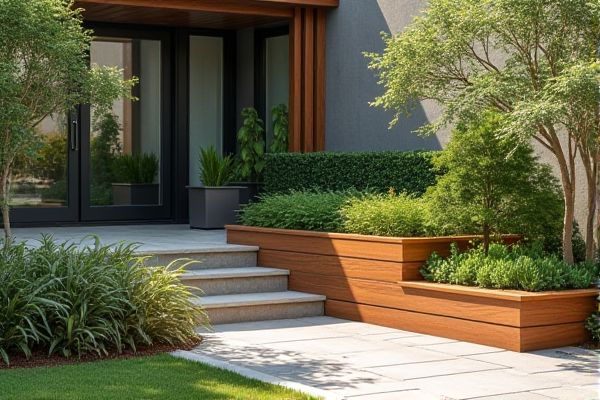
Raised planters offer improved drainage, better soil control, and easier access for gardening, making them ideal for those with physical limitations or poor soil conditions. To discover which option best suits your gardening needs and space, continue exploring the rest of the article.
Table of Comparison
| Feature | Raised Planter | Ground-Level Planter |
|---|---|---|
| Installation | Requires building or buying a raised bed structure | Simple, uses existing soil |
| Soil Control | Full control over soil type and quality | Depends on native soil composition |
| Drainage | Enhanced drainage, reduces waterlogging | Natural drainage varies by site |
| Pest Control | Reduces ground pests and weeds | More susceptible to pests and weeds |
| Accessibility | Easier access for gardening, less bending | Requires bending or kneeling |
| Cost | Higher initial cost due to materials and assembly | Lower cost, minimal setup |
| Lifespan | Depends on materials used, often longer lasting | Dependent on soil health and conditions |
| Temperature Control | Warms up faster in spring, extends growing season | Soil warms naturally, slower start in spring |
Introduction to Raised vs Ground-Level Planters
Raised planters offer improved soil drainage, better pest control, and easier access for gardening compared to ground-level planters, which are limited by native soil conditions. Ground-level planters maintain natural soil ecosystems and generally require less initial setup, making them ideal for traditional garden layouts. Your choice depends on factors like soil quality, space constraints, and gardening ease.
Comparative Overview: Raised and Ground-Level Planters
Raised planters provide superior soil drainage and reduced soil compaction compared to ground-level planters, promoting healthier root growth and higher crop yields. Ground-level planters offer easier access for large-scale agriculture and benefit from natural soil ecosystems, supporting beneficial microorganisms. Choosing between raised and ground-level planters depends on factors such as space availability, soil quality, and maintenance preferences.
Benefits of Raised Planters
Raised planters offer improved soil drainage and aeration, promoting healthier root growth and reducing risk of soil compaction compared to ground-level planters. They provide easier access for planting and maintenance, minimizing strain on your back and knees while protecting plants from pests and weeds. Enhanced temperature control in raised beds extends the growing season, allowing for greater plant variety and productivity.
Advantages of Ground-Level Planters
Ground-level planters offer easier access for planting and harvesting without the need for bending or lifting heavy materials, promoting ergonomic gardening. They provide natural soil interaction, allowing plants to benefit from native microorganisms and better water drainage. These planters are more cost-effective and versatile for larger garden spaces, adapting easily to various landscaping designs.
Soil Quality and Drainage Differences
Raised planters offer superior soil quality control by allowing gardeners to fill them with nutrient-rich, well-aerated soil, minimizing compaction and contamination common in ground-level planting. Enhanced drainage in raised planters prevents waterlogging by promoting efficient runoff, reducing root rot risks compared to ground-level planters where soil drainage may be impeded by native soil conditions. Ground-level planters often face challenges from poor soil structure and inconsistent moisture levels, impacting plant health and growth.
Accessibility and Ergonomics
Raised planters improve accessibility by reducing the need to bend or kneel, making gardening easier for individuals with limited mobility or back problems. Ground-level planters require more physical effort to access and maintain, potentially causing strain during prolonged gardening activities. Ergonomically, raised planters offer better posture support, minimizing discomfort and promoting a more enjoyable gardening experience.
Pest and Weed Control
Raised planters offer superior pest and weed control by elevating plants away from ground-dwelling insects and minimizing weed seed intrusion, reducing competition for nutrients and water. Ground-level planters are more susceptible to weeds and pests due to direct soil contact, requiring more frequent maintenance to prevent infestations. Your choice of planter impacts how effectively you can manage garden pests and weeds to promote healthy plant growth.
Cost and Maintenance Comparison
Raised planters typically involve higher initial costs due to materials like wood, metal, or composite, but their elevated design reduces weed growth and soil compaction, lowering long-term maintenance efforts. Ground-level planters are generally less expensive upfront but require more frequent weeding, soil amendment, and pest control to maintain optimal plant health. Your choice depends on budget flexibility and how much time you can dedicate to routine garden upkeep.
Aesthetic and Landscape Design Impact
Raised planters create a visually striking focal point by adding height and dimension to garden layouts, enhancing spatial organization and interest. Ground-level planters offer a seamless, natural integration with the surrounding landscape, promoting cohesive flow and unobstructed sightlines. Choosing between raised and ground-level planters depends on the desired balance between structural emphasis and organic harmony in landscape design.
Choosing the Right Planter for Your Garden
Raised planters offer improved soil drainage, easier access for planting and maintenance, and better control over soil quality, making them ideal for gardens with poor ground conditions or limited space. Ground-level planters support natural root expansion and typically require less initial setup, offering a cost-effective solution for larger garden areas with healthy soil. Selecting between raised and ground-level planters depends on garden soil health, accessibility needs, and space availability, ensuring optimal plant growth and maintenance ease.
 homyna.com
homyna.com